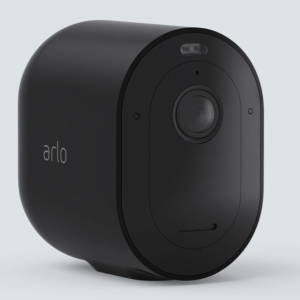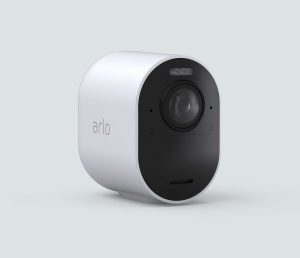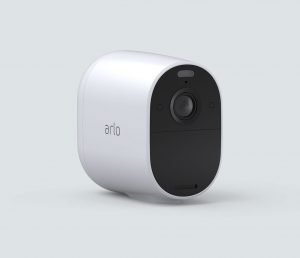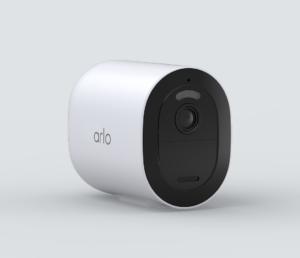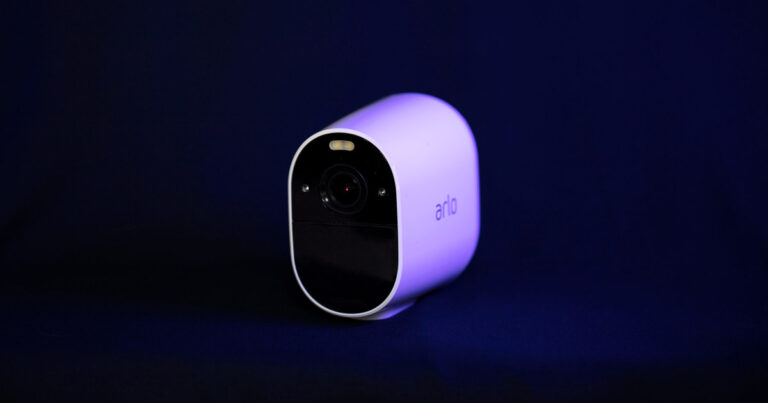Arlo cameras aren’t the most expensive out there, and they have impressive motion detection features, making them one of our most popular security camera recommendations. The biggest downside is that Arlo cameras require a paid subscription to access some of the best features. Keep reading our comprehensive guide to find the best Arlo security camera for your home or apartment. Here’s our stab at a quick-and-dirty summary. We’ll provide more depth as the review goes on.
Most Arlo cameras communicate without wall-fished wires (so you won’t need an electrician unless you buy the wired doorbell). Some Arlo cameras need to be continuously plugged in to work. Arlo sells outdoor, indoor, and doorbell cameras. Some Arlo cameras need hubs or base stations to connect to your smart home. Some don’t. Some Arlo hubs and cameras have local storage. Some don’t. Most Arlo cameras work with Alexa, Google, IFTTT, and HomeKit. Arlo has three different cloud storage/video streaming plans. You can’t use every plan with every camera due to varying storage needs and video quality capabilities.
Video quality is the main differentiator between many of the Arlo camera lines. The Pro, Ultra, and Essential lines are all similar in features but vary in price. Those prices are primarily determined by whether the cameras stream in 1080p, 2K, or 4K. So basically, if you’re just looking for a good camera, any of Arlo’s options should work for you. You’re one and done. But if you’re looking for a specific feature, then you’ll have to do a little more work to make sure you’re picking the right camera. The standard base station is compatible only with cameras that are now obsolete, like the Arlo Pro and Arlo Pro 2, so we won’t cover it in this review. Just know that it’s out there, and you might come across it as you look for the perfect Arlo camera. The base stations with sirens and SmartHubs work with Arlo’s current offerings. For the cameras with advanced object detection and other features that make Arlo worth the buy, you must get a paid Secure or Secure Plus plan. Without one, you can’t access most of your camera’s functions. If you’re thinking, “I’ll just get the cheapest storage option, no matter what it is!” then think again. The camera you buy will determine the plan you need. And, if you have a few different Arlo cameras with different plan needs, you could end up paying for both a Secure and Secure Plus plan each month. This is important to mention in case readers have previous experience with Arlo or have read other reviews that aren’t as recent. We don’t want to lose credibility because we’re using a different term than what they’ve heard before. But there’s a catch. CVR costs extra money on top of your subscription plan. You’ll spend $9.99 each month for 14 days of CVR or $19.99 a month for 30 days. And that’s only for the first Arlo camera. If you want to add CVR to more cameras, it’s an additional $4.99 each for 14 days or $9.99 each for 30. So if you have five Arlo cameras and want 30-day CVR for all of them? You’ll pay close to $60 a month on top of what you’re already paying for camera storage. That’s much higher than the typical fees for DIY camera systems. There have been many iterations of the Pro, some of which you may be familiar with. Over the last few years, Arlo has discontinued the Arlo Pro, Arlo Pro 2, and Arlo Pro 3. Currently, the company sells only the Pro 3 Floodlight and Pro 4. The main difference between these cameras is that the Pro 4 has a spotlight, while the Pro 3 Floodlight (predictably) has a floodlight. If you live on a busy street, motion detection push notifications can quickly become annoying. It’s better to get specific notifications, such as “Person detected” or “Package detected” so you know which notifications are important and which you can ignore. And that’s where Arlo’s top unique feature comes into play. However, to use this feature, you’ll need a paid subscription. You’ll get three months of Arlo Secure free, and then it’s time to pay. Or you can choose to go without a paid subscription, but you won’t be able to get the whole Arlo Pro experience. And without that full experience, it’s probably not worth it to buy Arlo. All the best features are wrapped up in the paid plans. The Arlo Ultra 2 has the following: The Ultra 2 requires an Arlo SmartHub or base station, so you’ll want to get one if you don’t have one. A light is also a a failsafe. If the color night vision experiences a problem, the spotlight will ensure your camera catches a clear picture of nighttime intruders. Note that the Arlo Ultra 2 comes with local storage ( a USB drive or SD card inserted directly into the hub), so you don’t necessarily need Arlo Secure for storage purposes. Once the battery charges, you’ll place it inside the camera and secure the camera to its mount. You’ll then follow the app’s instructions to complete setup and buy your Secure Plus plan. Like other Arlo cameras, the Ultra 2 is completely wireless. You don’t need to plug it into the hub or your router to work. So what makes these cameras so essential? They all have sirens and advanced motion detection, don’t use hubs, and still manage to be some of Arlo’s cheaper camera offerings. Affordable and user-friendly: nice. And that’s not all. Some of the Essential cameras have additional features. If you get the Essential Spotlight, you’ll also get the spotlight, outdoor weatherproofing, color night vision, zoom, an estimated six months of battery life, and Apple HomeKit compatibility. You’ll also get outdoor weatherproofing with the Wireless Video Doorbell. But unlike its counterpart, this doorbell iteration won’t work with Apple, at least according to the Arlo website. For instance, maybe someone is in your yard, trying to light your home on fire. (Unlikely? Yes. Impossible? No.) Your typical security system is powerless against that. But an outdoor or doorbell camera with a siren can both alert you to the intruder’s presence and scare off the would-be arsonist. Similarly, an indoor camera with a siren is a great way to augment a security system. It’s also a lower-cost way to get some of a home security system’s protection if you can’t afford the whole kit and caboodle. In both these instances, an Arlo Essential camera would serve the purpose. If you choose to connect the camera to an Arlo SmartHub, you can get free local storage too. Just remember that if you decide to go that route over a paid Arlo Secure subscription, you can’t use your object-detection features. We charged the camera and followed the app instructions to add it to our Arlo account. It only took a few minutes. We didn’t install the mount, so we can’t speak to that in detail—but according to Arlo user manuals, it isn’t complicated. You just need the kit, a pencil, and a drill or screwdriver to get it set up. You’ll need to turn off the power in your home, remove your existing doorbell, wire the new doorbell into place, and connect everything on the Arlo app. The Arlo website has more details about this process. Some DIYers are fine with this kind of installation, and some find it’s a little out of their comfort zone. If you’re nervous about working with home wiring, we suggest looking for an expert to help. If you have the wire-free doorbell, things will be much simpler. You’ll charge the battery, connect the doorbell to the app, and mount your doorbell wherever you want. Yes—since it’s not wired, we mean literally wherever you want—although if it’s too far from the door, people might not know to ring it. Currently, the only Arlo Go camera available is the Arlo Go 2. The Arlo Go 2 has the following: GPS location tracking solves that problem. As long as the camera battery has power, you can follow the camera location through the Arlo app. Which plan should you get? It depends on how much activity you expect. If you place the camera in a rural area with few visitors, the $5, 15-minute plan might be enough. But if you think your camera’s going to catch a lot of footage you’ll want to review, then you’re better off with a more expensive but more extensive plan. Arlo Mobile relies on AT&T and Verizon’s LTE networks to provide camera service throughout the US. That means that the Arlo Go 2 works like a smartphone. When it’s connected to Wi-Fi, LTE is unnecessary. When it’s not connected to Wi-Fi, the camera needs LTE to function. Place the battery in the camera and follow the app’s instructions to complete setup. Once that’s done, you can mount the camera if you plan to keep it in one location. Otherwise, you’ll probably want to leave it mount-less for easier travel. Arlo Pro: The Arlo Pro line streams in 2K. The older versions require a hub, while the two newest, the Pro 3 Floodlight and Pro 4, don’t. To access the full features, like advanced object detection, you’ll need to pay for a subscription. Arlo Ultra: Arlo Ultras feature 4K video and advanced object detection when you use the premium paid subscription. All versions require connection with an Arlo hub. Arlo Essential: This 1080p line features indoor, outdoor, and doorbell cameras. Hubs aren’t required to use the Essential cameras, but you’ll need a paid plan to take full advantage of the features, including Arlo’s signature advanced object detection. Arlo Go: The portable Arlo Go line offers portable cameras that use LTE connectivity. You’ll still need a premium paid plan for full use plus an Arlo Mobile plan for LTE access. If you aren’t feeling Arlo, we suggest trying Reolink, which is similar but with no hubs, fewer features, and lower prices. You can also check out cameras such as the Canary Pro and EufyCam 2. The main thing that makes Arlo cameras expensive is that you typically have to buy them in a multipack or with a base, bringing the cost way up. When you buy them one at a time, they’re much more affordable, especially if you wait and order them once they’ve been out for a while. While the indoor adapter cannot get wet, to our understanding, the outdoor power adapter is fine in inclement weather. There are exceptions, though. Some older Arlo cameras, like the Arlo Q and Arlo Go, come with rolling seven-day storage at no cost.
